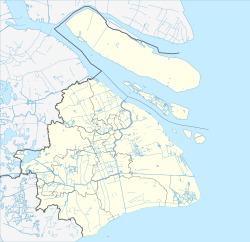Description
It is located in downtown Shanghai’s Huangpu District, between Yuyuan Garden and the Bund. [2] It is known as the Park of the Old City due to its location in an area where an old city wall was built. [2] One can take Metro Line 10 or Line 14 to Yuyuan Garden. From Exit 3 there's another 10 minutes' walk.
The park is home to a sunken plaza, a tea-house in a bamboo forest, a fishpond, and a lawn with topiary. An old kitchen in located in the park. After the park was reconstructed, residents living in old shikumen (stone-gate) houses had to relocate. A kitchen from one house was preserved and is now displayed in the park. It features a cement sink, old-style taps and blue-stone floor. There is a small bamboo copse located close to the preserved kitchen. There is an outdoor tea-house located in the park where tables and chairs are surrounded by high trees. [2] The mansion of the South Shanghai Bankers’ Club is located close to the tea-house that was built in 1883. It is a dark gray-and-white traditional Chinese-style mansion and is the location where first generation of bankers in Shanghai met. [2] Parts of the old city walls in Shanghai have been reconstructed in Gucheng Park and Danfeng Deck -an observation deck- was built on the original location of Danfeng Tower (a Taoist temple built between 1265 and 1274 which was the highest point in Shanghai a few hundred years back, being demolished in 1912).
This page is based on this
Wikipedia article Text is available under the
CC BY-SA 4.0 license; additional terms may apply.
Images, videos and audio are available under their respective licenses.

